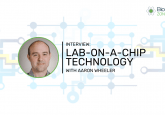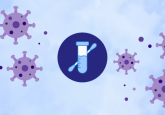Lab-on-a-chip could rapidly detect multiple pathogens using smartphone device

A novel point-of-care platform to diagnose infectious diseases has been developed by a multidisciplinary group including the University of Illinois at Urbana-Champaign (IL, USA) and the University of Washington at Tacoma (WA, USA). The detection instrument utilizes a smartphone along with a test kit using the format of a credit card.
Results demonstrating the detection of four respiratory diseases are published in Analytical Chemistry and the use of the system to diagnose the presence of a virus, in a droplet of whole blood, is reported in Biomedical Devices.
The system is low cost and portable and could provide a solution to the challenges of diagnosing infectious disease, particularly in resource-limited environments and settings where an immediate result is required. Integration with mobile communication technology allows the tool to aid personalized patient care and crucially, in approximately 30 minutes, the system can achieve detection limits comparable to those possible with laboratory-based methods and instruments. It is useful for human point-of-care diagnosis to simultaneously test for multiple pathogens within a single test protocol as this reduces costs, time and effort.
A commercial smartphone is used in the system to acquire and interpret real-time images of an enzymatic amplification reaction taking place in a silicon microfluidic chip. This generates green fluorescence and allows a visual readout of the test. The device is made up of an unmodified smartphone with a portable 3D-printed cradle to support the optical and electrical components and to interface with the camera of the smartphone.
Information is gathered by software on the smartphone about the tests conducted on the microfluidic card. Patient-specific information and the results from the assays are also transmitted to the phone. All this data if then communicated to a cloud storage database. It is hoped that through using the technology, disease can be diagnosed more rapidly in the clinician’s office or in the field and will hopefully lead to earlier and more informed patient decisions.
Sources: Chen W, Yu H, Sun F et al. Moblie platform for multiplexed detection and differentiation of disease-specific nucleic acid sequences, using microfluidic loop-mediated isothermal amplification and smartphone detection. Anal. Chem. doi:10.1021/acs.analchem.7b02478 (2017); www.sciencedaily.com/releases/2017/10/171019100408.htm





